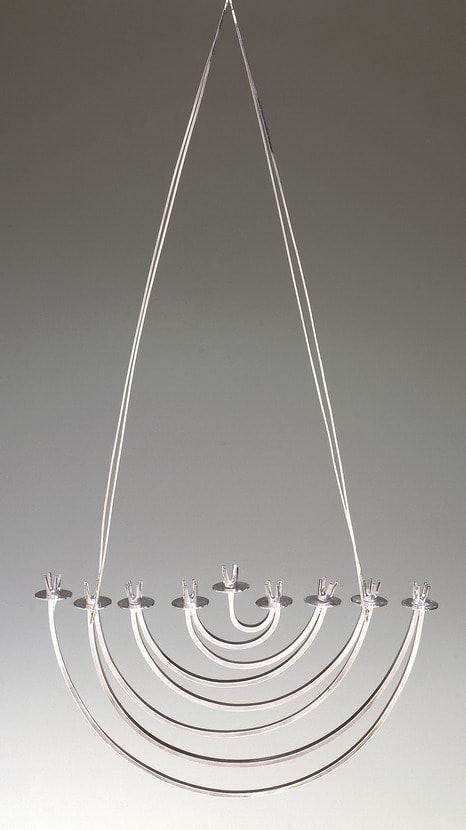
- Object Name:
- Hanukkah Lamp
- Artist/Maker:
- Ludwig Yehuda Wolpert
- Bio:
- b. 1900, Hildesheim, Germany; d. 1981, New York
- Place Made:
- New York, New York, United States
- Date:
- 1978
- Medium:
- Silver: hand-worked
- Dimensions:
- 20 7/8 × 10 7/16 × 1 1/2 in. (53 × 26.5 × 3.8 cm)
- Credit Line:
- Gift of Herbert and Shirley Jacobs in memory of Naomi Routtenberg
- Accession Number:
- JM 32-78
Not On View
Ludwig Yehuda Wolpert is regarded as one of the greatest Judaica artists of the twentieth century. His contribution to Jewish ceremonial art is tantamount to the role that the Bauhaus, Mies van der Rohe, Eric Mendelsohn, and other pioneers of the modern design movement played in changing the outlook of modern architecture and design. Wolpert reshaped a late-nineteenth-century art form that had looked to the past for its inspiration and infused it with the aesthetic spirit of the twentieth century.
Wolpert's artistic career began with private sculpture instruction and a program of study at the School of Arts and Crafts in Frankfurt, Germany. In 1925, he embarked on a three-year study of metalsmithing, which he then used to develop designs for Jewish ceremonial objects. By 1931, he had succeeded in combining his training and interests in the creation of a remarkable silver-and-ebony seder plate, that was first exhibited at the Berlin Museum of Arts and Crafts. The work was a radical step for ceremonial art as it employed a geometric functionalist style associated with the Bauhaus and modernism. It marked a turning point for Judaica. Wolpert's approach to his work was straightforward; the surface was kept plain so that the decoration did not overwhelm the object or detract from the beauty of the metal. The artist used conventional fabrication techniques to shape, pierce, and overlay his works. Elegantly proportioned and uncluttered, his work exudes a sense of the sacred and mystical, a quality that is palpable even to those unfamiliar with Jewish rituals or Judaica. Part of the remarkable "inner content" that the artist strived for in his work came from his encyclopedic and intimate familiarity with Jewish literature, history, liturgy, and symbolism.
Wolpert brought the same vitality to his designs for Hanukkah lamps-a substantial collection of which is in The Jewish Museum. His superb design sense and understanding of proportion is particularly evident in this example, a 1978 hanging Hanukkah lamp which is composed of a single band of silver that zigzags back and forth in a series of arcs, creating a highly schematic menorah shape. Here Wolpert reduced the menorah form to its leanest essentials.
Wolpert favored Hebrew letters as ornamentation for his works. His ceremonial objects "bloom with imaginative versions of the ancient calligraphy", which he carefully selected to complement the purpose of each piece. The letters represent far more than mere decoration. They were a means of expressing the sacredness of the Hebrew alphabet and a way to create a spiritual aura for his ceremonial works. The Hebrew alphabet was Wolpert's most important motif, and he used it extensively in his Judaica and sculpture, treating it with an almost mystical reverence.
Wolpert became the first widely known artist to make ceremonial Judaica a life's work rather than the focus of an occasional commission. His pioneering work quietly revolutionized an entire genre.
Wolpert's artistic career began with private sculpture instruction and a program of study at the School of Arts and Crafts in Frankfurt, Germany. In 1925, he embarked on a three-year study of metalsmithing, which he then used to develop designs for Jewish ceremonial objects. By 1931, he had succeeded in combining his training and interests in the creation of a remarkable silver-and-ebony seder plate, that was first exhibited at the Berlin Museum of Arts and Crafts. The work was a radical step for ceremonial art as it employed a geometric functionalist style associated with the Bauhaus and modernism. It marked a turning point for Judaica. Wolpert's approach to his work was straightforward; the surface was kept plain so that the decoration did not overwhelm the object or detract from the beauty of the metal. The artist used conventional fabrication techniques to shape, pierce, and overlay his works. Elegantly proportioned and uncluttered, his work exudes a sense of the sacred and mystical, a quality that is palpable even to those unfamiliar with Jewish rituals or Judaica. Part of the remarkable "inner content" that the artist strived for in his work came from his encyclopedic and intimate familiarity with Jewish literature, history, liturgy, and symbolism.
Wolpert brought the same vitality to his designs for Hanukkah lamps-a substantial collection of which is in The Jewish Museum. His superb design sense and understanding of proportion is particularly evident in this example, a 1978 hanging Hanukkah lamp which is composed of a single band of silver that zigzags back and forth in a series of arcs, creating a highly schematic menorah shape. Here Wolpert reduced the menorah form to its leanest essentials.
Wolpert favored Hebrew letters as ornamentation for his works. His ceremonial objects "bloom with imaginative versions of the ancient calligraphy", which he carefully selected to complement the purpose of each piece. The letters represent far more than mere decoration. They were a means of expressing the sacredness of the Hebrew alphabet and a way to create a spiritual aura for his ceremonial works. The Hebrew alphabet was Wolpert's most important motif, and he used it extensively in his Judaica and sculpture, treating it with an almost mystical reverence.
Wolpert became the first widely known artist to make ceremonial Judaica a life's work rather than the focus of an occasional commission. His pioneering work quietly revolutionized an entire genre.
Information may change as a result of ongoing research.